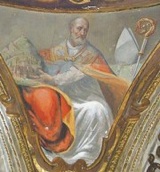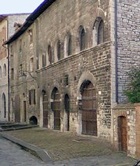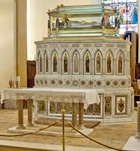


Fresco (1654-8) of St Ubaldus by Francesco Allegrini
Cappella del SS Sacramento, Duomo

St Ubaldus was educated at San Secondo and then at San Mariano. However, he disapproved of the way of life of the clergy of San Mariano and was back at San Secondo in 1104, when the old Bishop Rustico died and was succeeded by St John of Lodi. At the request of the new bishop, St Ubaldus returned to San Mariano.
St Ubaldus was ordained in 1114 and was elected prior of the San Mariano some four years later He was sympathetic to the cause of Church reform and imposed an ascetic rule on his community. [He imposed what is known as the Portuense Rule, which Pope Paschal II had confirmed in 1116 for a community of regular canons at the church of Santa Maria in Portu on the island of Corizo near Ravenna. This rule subsequently became widely diffused in Italy, France, Spain and Germany.]
When a fire in 1126 destroyed much of Gubbio, including the Duomo and the Canonica, St Ubaldus fled to the Eremo di Fonte Avellana, intent on dedicating himself to the monastic life. He was however persuaded to return to Gubbio, and he became its bishop in 1129, just a year before the start of the papal schism. His support for Pope Innocent II (perhaps because this was the candidate pressed by St Bernard of Clairvaux) seems to have been influential in deciding the obedience of the cities of Umbria.
One of his first acts as bishop was to begin the rebuilding of the city. He also calmed the civil unrest in the period 1135-40 that culminated in the establishment of the commune and the election of Consuls. In 1151, exiled nobles from Gubbio seem to have mobilised support from some eleven neighbouring cities, including Perugia, Città di Castello, Nocera, Foligno, Spoleto and Assisi, and a force under Perugian leadership attacked Gubbio. However, St Ubaldus had rebuilt the walls of the city, and the invaders were forced to mount a siege. Fortunately, St Ubaldus was able to dispatch soldiers to the surrounding mountains under cover of darkness. The following day the besieging army at Montelovesco di Gubbio found itself surrounded and was forced to withdraw.
His help was needed again in 1155, when the Emperor Frederick I, who was camped with a large army at Gualdo Tadino after the sack of Spoleto, demanded a huge payment from Gubbio. St Ubaldus pleaded with Frederick I, who was so impressed that he left the city in peace and granted it a number of territorial privileges.
When St Ubaldus died in 1160, he was buried in the old Duomo, beside the relics of SS Marianus and James. In 1188, Pope Clement III gave permission to Bishop Benedetto Bentivoglio for the translation of the relics of the saints of Gubbio (presumably including the body of the future St Ubaldus) from the “antiqua civitate” to the site on the mountain, where the “civitas de novo”had been constructed.
Theobald II, a monk from Fonte Avellana who succeeded St Ubaldus as Bishop of Gubbio, wrote his biography (BHL 8355-7) in 1163 and dedicated it to Frederick I . An almost contemporary work was written by Giordano di Città di Castello (BHL 8354). This culminated in the canonisation of St Ubaldus by Pope Celestine III in 1192. (BHL 8357 documents a church dedicated to St Crescentian (probably the Pieve di San Crescentino, Cantiano) and a church dedicated to St Orphitus, one of the associated Martyrs of Saddi).
Relics of St Ubaldus
In 1194, his relics translated from the Duomo to a small oratory at the summit of Monte Ingino, which was near an oratory that was dedicated to the Milanese SS Gervasio and Protasio. (This was later to become the site of Basilica di Sant’ Ubaldo, and recent research has located the oratory under the present campanile). It is likely that this site was chosen so that the soldiers stationed at the nearby Rocca Posteriore could protect them.
Two sarcophagi that previously contained the relics of St Ubaldus were brought here in 1997 from Santa Maria Nuova:
-
✴The sarcophagus (13th century) to the left of the apse was decorated with panels (early 14th century) that are attributed to the Maestro Espressionista di Santa Chiara (Palmerino di Guido?).
-
✴The relics were transferred to the sarcophagus (18th century) that now stands to the right of the apse in 1721.

Corsa dei Ceri
On 15th May each year, the city celebrates the Festa dei Ceri (Feast of the Candles). This may well have had pagan origins, but it has long served as a celebration of the famous victory of 1151. Three enormous wooden structures representing candles, each of which is connected with a particular neighbourhood and trade, are carried up the steep hill to the church of Sant' Ubaldo. This is not a race: the team with the structure that carries an image of St Ubaldus is always the first to reach the summit.
Read more:
S. Brufani and E, Menestò (Eds), “Nel Segno del Santo Protettore: Ubaldo Vescovo, Taumaturgo, Santo: Atti del Convegno Internazionale di Studi, Gubbio, 15-19 Dicembre 1986” (1990) Spoleto, reprinted 1992
Return to Saints of Gubbio.

